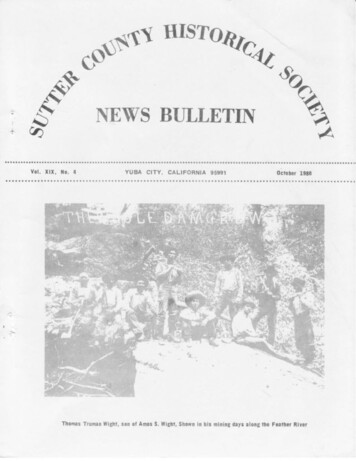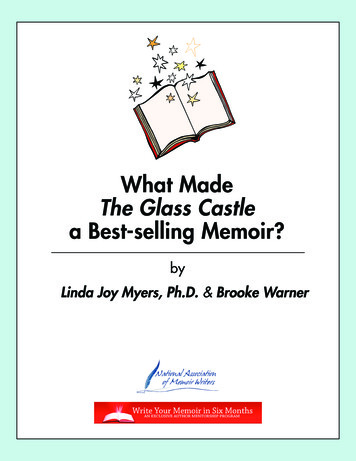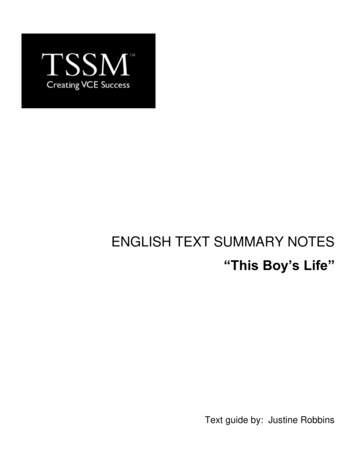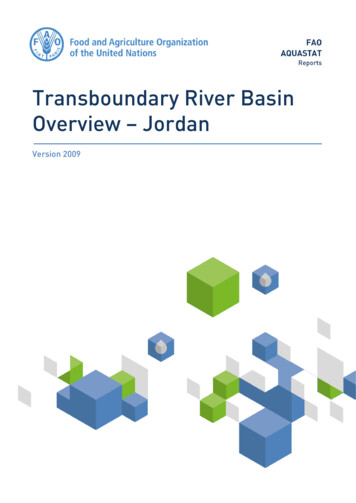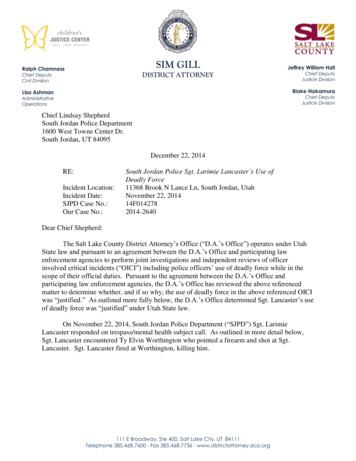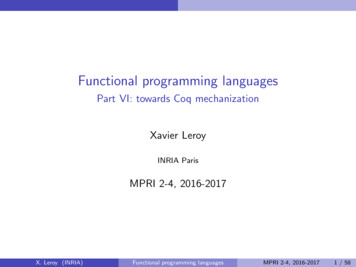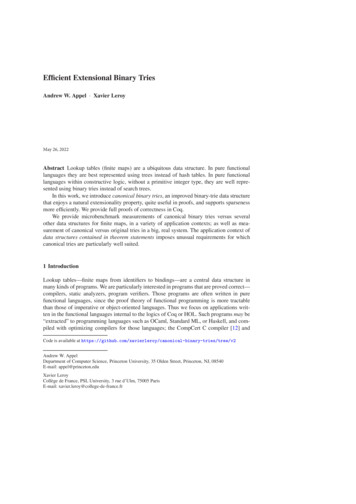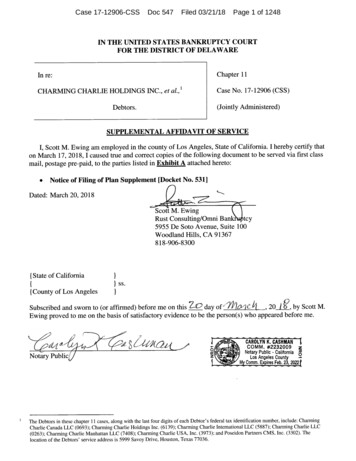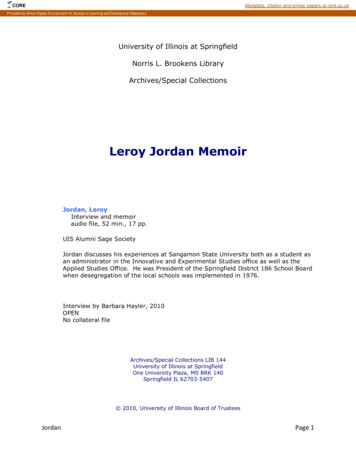
Transcription
COREMetadata, citation and similar papers at core.ac.ukProvided by Illinois Digital Environment for Access to Learning and Scholarship RepositoryUniversity of Illinois at SpringfieldNorris L. Brookens LibraryArchives/Special CollectionsLeroy Jordan MemoirJordan, LeroyInterview and memoiraudio file, 52 min., 17 pp.UIS Alumni Sage SocietyJordan discusses his experiences at Sangamon State University both as a student asan administrator in the Innovative and Experimental Studies office as well as theApplied Studies Office. He was President of the Springfield District 186 School Boardwhen desegregation of the local schools was implemented in 1976.Interview by Barbara Hayler, 2010OPENNo collateral fileArchives/Special Collections LIB 144University of Illinois at SpringfieldOne University Plaza, MS BRK 140Springfield IL 62703-5407 2010, University of Illinois Board of TrusteesJordanPage 1
Narrator: Leroy JordanDate: March 19, 2010Place: Springfield, IllinoisInterviewer: Barbara HaylerQ. Good, good, all right. We’ll put the microphone on this. We’ll just lay it out there.A. Looks good, yes.Q. Well I realized when you were talking about this that I didn’t actually know how you came tofind out about Sangamon State and how you first got connected with it. So if you don’t mind,maybe we could start there.A. Sure, in the summer of 1971, I was working on my master’s degree at SIU Edwardsville andhad finished up about three-quarters of a degree when Sangamon State University opened up.So I was one of the charter graduates with a master’s in administration. In those days it wasadministration; it was a generic administration degree. It was sort of like having anadministrative degree but specializing in education.Q. Oh yes, and then that became ed. [education] administration.A. Business administration and so that’s how I was a charter graduate in June of 1972. Well, inSeptember, I started working with the university as the Assistant Director of Applied Studyprogram. John Haworth was the director; he hired me at that time.I had met him through the Rotary. I made a presentation about vocational ed. to the Rotary. Ihad taken a job with the research and development unit of the state Board of Education, and Imade a presentation to one of the Springfield Rotary Clubs about career education. John heardme there, and he sent me an application about the opening in applied studies. I applied for itand got the job. That was back in 1972. In August 1972, I started working for Sangamon StateUniversity.Q. Right, so you weren’t necessarily looking for this job.A. No.Q. It kind of found you.A. Yes, yes. And actually it was a great job because I was always interested in student learningand this kind of brought in the theory and the practice, which I was always in favor of. So bybeing the assistant director, it was the ideal job really.Q. Had you been working for an ed district or something before that?JordanPage 2
A. Sure. I started working in the School District 186 in 1965, an elementary school teacher,taught seventh and eighth grade at Iles School. And in 1969, I took the job with the StateDivision of Vocational Ed in the research and development unit. I worked there from 1969 to1972, and then I came to the university.The research job was basically that the federal government had passed a Part C of theVocational Education Act. Illinois’ response was to set up a research and development unit thatwe would fund research initiatives having to do with career education or voc ed. Thedevelopment part was to identify exemplary programs across the State of Illinois in variousoccupational fields. My job was to handle that end of it so I would go to communities likeSalem, Illinois that had an outstanding home ec [economic] program. The program broughtstudents into contact from a theory and practice standpoint, so we set up a demonstration sitethere.Q. I was going to say, not like when I was a kid and just heated up canned tomato soup as a kid.A. No, no, it was much more. It was still hands on but it had some very solid educationalprinciples behind it. So across the State of Illinois we would have maybe a joint agreementbetween two or three school districts or we would have something new in terms of computer.One project was CVIS; we called it Centralized Vocational Information System, and it wasprobably one of the first computer projects in a cooperation between IBM and the WillowburgHigh School District. And that’s when they starting having kiosks and information on voc ed soa student could go in and type in a subject and the information would come up describing it andthings of that nature, Project CVIS.And so it was a forerunner of a lot of things that are just common now. But that was my job tohighlight those programs, do all site visits, visits to make sure they were doing what they weresaying they were doing. And if we liked it, then we would set up drive in conferences whereother teachers could come, get the information, view the operation. And if they wanted to,carry it back to their home school students. So that’s how I got into innovative education.Q. And then someone talked you into joining the District 186 school board, right?A. Yes, that was in 1975. I had always been interested in the local school system anyway, butthat year, I think 1974 or thereabout, Bill Logan and John Lambert came by my house and askedme if I would be interested in running for school board. Of course, the faculty, Larry Goldenand Cullom Davis, just the whole university community was interested in someone doing that.And primarily, I guess, the impetus of that was the multicultural institute, which was headed byGus Stevens and Jim Pancrazio. I’m trying to think who else was there, maybe Bob Zeller. Theinstitute was university (SSU) based, and it was trying to change the local school district byhaving teachers participate in this multicultural institute. They started all kinds of courses andJordanPage 3
seminars where teachers met with some of the local citizens while getting the universityinvolved. I ran for school board and I won (laughter).Q. Yes.A. I tell you that having the university as a foundation, I could come up with different questionsor look at different research studies. I could get synopsis of what was going on in the country,so it was great. Plus it helped me organize the community into supporting my candidacy. Wehad a slogan. Our slogan was STP.Q. Like the greasy additive?A. Yes, we called it Students, Teachers, and Parents.Q. Now Loretta Meeks still has that project STP now. Did that kind of come out of thismulticultural thing?A. Yes, it did, yes. But many years later it was the same idea as Students, Teachers, andParents. That one now I think the acronym was different. It was like Student TeacherPartnership or something like that.Q. YesA. Same kind of idea, so yes.Q. All right, so you were actually a student at SSU but only for a year?A. Yes, less than a year.Q. Less than a year?A. Yes, it was really well probably a year, two semesters probably I was out there. So Istarted there as a student in the fall of 1971, graduated that spring, 1972.Q. Fall of 1971 was the first year that students enrolled, right?A. Well there some there in the fall.Q. Would it be the fall of 1970?A. Well, the university started in 1970, fall of 1970 and I think students started enrolling in thespring of 1971.JordanPage 4
Q. Spring, ok. Well, there’s. I mean, was it just the distance or were there other things aboutSSU that encouraged you to attend?A. It was distance and also how the degree was described, how the programs were describedthere. And I liked the generic nature of the administration degree because you could be ateacher, you could go into education, you could be an administrator of a school. You could gointo education as being a school finance officer; you could go into education from a lot ofgeneral administrative positions. It increased your options of what you could do with youradministrative degree, so that was kind of very attractive at that time.Q. Ok, instead of being really focused on a particular credential for a particular kind of thing.A. Right. This would offer you an opportunity to not lock yourself into one area, so it was good.Q. Did anybody in the teaching program in the ed program, anybody who was there have aparticular impact on you as a student?A. Well, one was Otis Morgan. Otis was a black professor in education there.Q. He was gone before I was.A. Yes and another was Stewart Anderson, who was a professor in education. I’m trying tothink of who else. Of course everybody had a course with Bob Batson.Q. Oh, yes. Mr. Administration.A. That’s right (laughter). Everyone had a course with him. And then at some point there wereprofessors that came from other universities like SIU Edwardsville and Champaign that taughtcourses in particular curriculum. But yes, those few I definitely remember their courses.Q. Was there like a particular kind of project or something that sticks in your mind? I mean, Iknow that’s been a long time back. I remember one professor I had who, the way he didcertain assignments was something I tried to follow for a long time.A. Yes. Well, I would think of I would speak of Mark Conway, and he was actually a biologyprofessor, but he taught a PAC course called, Mood of Black America. Of course, this was ageneric course but it taught about not only the social things that were going on but also thephase of education and what impact discrimination had on students. And so I was veryinterested because I was teaching school in the daytime at Iles School, which at that point wasgoing through a transition of demographics.Q. Ok, so you were still teaching full time and then driving down to Edwardsville two or threenights a week, would have been a real burden.JordanPage 5
A. Yes, it was. And I used to say that if when I was enrolled at Edwardsville, I could be inChicago in the morning and then have to come back, stop at home, get refreshed up, and go toclass down in Edwardsville every evening. It was just kind of wearing me down.But Mark’s course was one that I was interested in because it kind of gave me an opportunity tolook at research at Iles School in terms of how students learn and things of that nature. And Icould then begin to peak my interest in this whole thing that they called racism and the impactit was having on student learning.Q. Well, having a biology professor teaching a PAC about the black, the mood of black Americawrit large but dealing with education and social, I mean that just seems so SSU somehow.A. Yes, it is (laughter). That’s what we were about, yes, very much so. And it, of course, wasvery popular and brought in students from all disciplines and the community. People come outand made presentations. That’s where I first really got to know Velma Carey. I knew of VelmaCarey, but she came out and made a presentation because at that point I think she was workingwith the Springfield Urban League.Q. That’s right.A. And she came out and made a presentation. I met Charles Lockhart through that programbecause he was also in the same class that I was, and he was working on his master’s degree atthe same time. And Bill Logan and just a lot of us were around at that point. So it gave us achance to not only do the learning part but to get involved in student government and things ofthat nature, so it was really an interesting time.Q. Now I know back then, I think graduate students as well as undergraduate had to have somekind of a graduation contract then, do you remember?A. Yes and it was a document that basically spelled out what you wanted to get your degree in.It was almost like an individual option proposal really, it was very similar. And you would signoff on it and then you would have your advisor sign off and the Dean of the program that youwere in would sign off. That kind of guided you in terms of what courses you were going totake. If there were any changes in it, you had to amend your contract.Q. So that implies there wasn’t much in the way of required courses in the huge degree?A. Right. I think there were, oh I can’t remember, but you had to have so many courses thatdealt with like a couple finance courses, maybe one public administration course, and thenthe rest would be in education and like that. And then everyone was required to take a PAC.Q. I remember that. They were a mixed bag, the PACs at that time. There were a lot ofdifferent things being done as PACs.JordanPage 6
A. Yes, there were. I was trying to remember, of course, when I became Dean, the innovativeand experimental studies program, I think they went to the cluster.Q. Cluster.A. Yes, cluster, Dean of Innovative and Experimental Studies Cluster. Oh, there were so manyPACs that had to be offered, were offered by your cluster. That was part of the contract or bill.Q. I remember they sort of would say, well you’re responsible for x number this semester.A. Yes, I remember that. And that was a great idea having a PAC committee who would Iremember Earl Rollins (laughter) from biology. He was like the father of PAC. When I firststarted out there, he was the head of the PAC committee. That goes back many years. Yes, Earland Ann Larson were really the two from the PAC committee from biology. Yes, so that wasinteresting.Q. Now did you have to do a graduate project of some kind?A. You could. I think if I am correct that there were two ways you could do it. One was kind ofa project, which dealt with the practice. You could design something or work with anorganization, in state government, or in the community as your final project. Or you couldwrite a paper of some nature having to do with say, a critical issue at that time. So there weretwo options at that point for doing your graduate project.Q. Do you remember which one you did?A. Yes, I did the paper (laughter). In my paper, it came out of the course, The Mood of BlackAmerica. It was kind of researching and looking at student grades and stuff like that. I wasalways interested in the psychology of learning, so I was trying to look at what impact home lifeand those sorts of things had on student learning. I have to go get that paper, look at it. I’venever thrown anything away.Q. My thesis was on the Oakland, was the beginnings of the Oakland Project.A. Oh, yes.Q. And introducing EEO programs into Oakland, fascinating.A. Well yes, that raised some exciting initiatives, that’s for sure.Q. Well, looking back on it now, what would you say about how well that kind of education,which was only part of your graduate education I know, how well it served you?JordanPage 7
A. I think very well, yes. I tried to think about it in relationship to my career and what I wouldhave liked to have known more about or how to do. I don’t think there were any holes there. Ithink I’d be hard pressed to really think of something that I wish I would have taken as a course.So my degree served me really well, probably more, maybe more at the master’s level maybemore research. I think when I started working on my PhD, it would have been good to have hadsome experience with, what is it? SPSS?Q. Oh, yes, SPSS.A. Yes, SPSS. Really at the master’s level if I would have got a touch of it, it wouldn’t have beenso frightening.Q. That’s always tough when you first start on it, and you did that at ISU?A. Yes, Illinois State. I started, I didn’t finish.Q. You got through all the class work?A. All the classwork, yes.Q. And you’re the distinguished ABD [All But Degree]?A. Yes. After that, my health started going south so to speak and so I never really got finished.Like I said, I could be one of those people that you see come in at SSU that finish their degrees.Remember, who was it? Mr. Budinger and several citizens who came and got their masterswere in my graduating class at SSU. Frances Budinger, I cannot forget him. Frances Budinger.Q. That’s with D, isn’t it?A. Uh-huh.Q. The name is familiar, but I have trouble placing him.A. And I think Judy Barrington’s father went out there, too.Q. Barringer, the doctor? No?A. Yes, I think he was a doctor. But if I’m not mistaken, he got a second master’s out there.Q. Oh, yes because he took some oral history, local histories.A. Yes, yes, I think so. And then of course there was Evelyn Pollack at that time.Q. So coming to school not right out of undergraduate school didn’t set you aside at all?JordanPage 8
A. No, no.Q. That was kind of the norm then. In fact, you were a pretty young guy compared to all therest.A. Yes, I was. I forget how old I was, but I was in my thirties when I started. But it was a richenvironment. I mean the idea of having senior students and then middle aged students, youngstudents—young in the sense of being over twenty.Q. But under thirty?A. Oh, under thirty, yes. It’s a great time.Q. Well, I think it’s interesting that most of the students that were recognized in the AlumniAssociation come from that time, come from the 1970s. They all talk about what a stimulatingkind of environment it was to deal with so many different kinds of people.A. It was, it was very much so. I’m on Facebook. I have people saying, Mr. Jordan, I rememberwhen I did my applied study and you were my supervisor. And by and large, most of them aredoing real well in their careers so that’s interesting.Q. Now when you were first hired, the campus was totally downtown, right?A. No, well it was but that fall when I came here in 1972, we were over in the G wing.Q. Oh yes, where art went later.A. Yes, we were over there.Q. So they built those temporary buildings that we’re still using.A. Temporary, right.Q. In 2010.A. Temporary permanent buildings (laughter). Yes, we were located in the G wing. And it wasmyself, John Haworth, and Dottie Troop.Q. So Dottie was there?A. Dottie was there. She was a charter graduate, too. I think she may have been hired acouple of months before I was. She was there, and I think initially there was suggested to havetwo assistant directors. And I guess some of the incorporations did not go the way they wereJordanPage 9
supposed to do. So I ended up as the Well, I think we did have two. I think we were both thesame pay grade and I was assistant director.Q. And with John head of it.A. Yes, John was the head of it. So it was me, Dottie, John, and Marianne Smith was oursecretary at that time. I haven’t heard from her for years. But occasionally I run into Dottie,and, of course, John died a couple of years ago, so interesting times.Q. So as one of the assistant director’s, would you have been teaching seminars and directlysupervising people or what all did you do?A. Well, of course, we developed placements and that was part of it. If someone wanted tohave a student, one would go out and do an interview, sort of conduct an interview of theagency or organization. That was one function. Another one was to constantly advise students,share with them the various options. And then the third one was, each one of us had a role interms of representing our program in the university curriculum committees, the PACcommittee. Then there was a general assembly.Q. Was it the general ed committee that handled the Assembly?A. Yes, yes. Each one of us had a role to play in different parts of that as well; work directlywith students in doing on site visits to the agencies where the students were placed.Q. How would that have worked? I mean it was kind of a new program. How would it gotypically to if you tried to develop a placement?A. Well, the first thing, usually we tried to develop a placement based on a student interest. Soif a student came in and said, “I want to work at McFarland. I’m interested in psychology, and Iwould like to have that kind of experience” They wanted to know the process as it relates to acounseling service or whatever. From there, we would see if we had placements in that area. Ifnot, then we would begin going through the process of identifying organizations or businesseswhere the student might get that experience. And if that was the case, then we would find outwho was the supervisor or the person in charge of personnel at that agency and make contactwith them. They would go off to visit the agency and talk about what the students might beinterested in. Sometimes we would even go as far as to set up the match between the studentand the employer while we were there—become like their negotiator, the middle person inestablishing the relationship.Q. You would do a lot of the equivalent of cold calling. You would just call someone up andsay, “I know you have not contacted us but ”A. Yes, it might involve a conversation, you get the letter together and a brochure about theprogram and send it to the person and say, “I will contact you in two or three days or a weekJordanPage 10
and set up a visit or come out and visit with you.” And the community knowing the universityand everything they were very receptive to having our students.Q. Well it sounds like you didn’t go out and set up a whole bunch of placements first. It wasmore student-driven. That sounds like what you’re describing.A. Yes, it was. If you set up the placement first and then you would have to guess, and youworried or you would not know what questions to ask unless you had some idea of what thestudent wanted to do. And then you could say, “Well I want to go to a placement in social worksay for example.” What does that mean? Do you want to learn how to manage a budget insocial work institution? Do you want to learn how to be a supervisor? Do you want to learnhow to be a case worker? So a lot of it was student driven in terms of their interest. Theycould get pretty specific. I can remember a couple [of placements] in biology where thestudent wanted to work in the lab at SIU Med where they dealt with creating samples of germsin the petri dish kind of stuff. They were actually getting a lot of hands on exposure.Q. Yes, they were actually culturing activitia or something?A. Yes.Q. Work in a lab?A. Work in a lab. We had students at the Department of Agriculture in their science lab, whichdealt with nematodes (laughter) and all that kind of stuff. It was totally different then workingin a hospital lab, so it was interesting.Q. So you did a lot of interviewing of students to begin this process?A. Oh, yes. At that time, of course, the applied studies were required for all undergraduatestudents. And often times we crossed that line in helping graduate students, too. While wemay not have been supervising for graduate students we helped. I’m trying to think, they wererequired for the undergraduate student; it was an eight hour requirement. I think a graduatestudent had the option of doing a full semester intern or four hour experience, so sometimes itwas a matter of helping them, too. Some crossover came especially as it relates to legislativestudies or in those fields where they would be making contact with the Legislature.Q. Were any of those programs in place like at the legislative intern program?A. It came I think in 1979-1980. It was very early 1980s.Q. Very early 1980s. So when you first started that, those separate programs didn’t exist. Itmostly went through the AST.JordanPage 11
A. The individual programs, yes. It wasn’t as structured as much because it was essentially anindependent study for the graduate student. But once the centers got started, it became moreroutine or structured in that sense.Q. When I came here, I remember people were talking about other places had internships butthey were pretty much all run through individual departments. They were almost neverrequired for everybody. They were an option.A. Right.Q. So it sounded to me like the way you and John set this program up was very different fromkind of the routine way in which it could have been done.A. Yes, and that was John’s motto and I think prior to SSU he had worked in state governmentwith a Department. Not like education but he would also have been exposed to the Universityof South Florida.Q. That was another upper division, wasn’t it?A. Right. So he kind of brought their motto here to Springfield. And he was well learned andhe had been visited and done some time talking to the people in Drexel University and Antiochand Empire state. There was a growing organization; it was called CAEL, Counsel ofExperimental and Learning Education.Q. That organization still exists.A. It does, yes. I thought I got the name wrong, but if CAEL is still around. Also at the sametime there was another organization called Society for Field Experience Education. Whenbetween the two of them it became a very powerful network across the country in universities.I would say CAEL was the forerunner; the Society of Field Experience Education was the second.If you felt CAEL was too restrictive, then you went with SFEE.Q. You went to the other one.A. Yes, if CAEL was not grass roots enough, then you went for the Society for Field ExperienceEducation.Q. Then after a few years John moved on and you became head of the Applied Study Program?A. Yes, John went back to the State Board of Vocational, the State Board of Education and thenI became the Director of Applied Studies.Q. And that was in?JordanPage 12
A. 1974.Q. 1974.A. So I directed the program from 1974 to 1982 or 1983. The reason I say that because MikeQuam was my Dean when I was Director of Applied Studies. I think that was like 1982, 1983,1984 or somewhere in there.Q. Oh, it was earlier than 1984.A. Was it?Q. I got tenure in 1984 and by then you were the head of the cluster.A. Yes, then I was Dean.Q. Dean of the cluster. We created those clusters under Alex Lacy.A. Alex Lacy.Q. That would have been 1981, 1982.A. That was it, yes, Alex Lacy.Q. So originally applied study was in some general college?A. Yes. It was set up, there were two requirements. One was everyone was required to do aPAC course. There were three then because there were PACs, applied study, and thenuniversity courses.Q. Yes, but the UNI [university] courses weren’t required.A. They were not, no.Q. At least not in the 1980s, maybe in the 1970s.A. No, they weren’t required.Q. Oh, you’re thinking about what was in that cluster.A. In that cluster for the university. All university catalogs, there was the three, and I’m surenothing. So we were located initially, I think if I’m correct in the same, we were university wide,but Jerry Curl was our Dean. And Jerry was in ADC. I think he had teacher ed, counseling; wewere in one of the university, they had several university-wide schools and then they went toJordanPage 13
clusters. And so we were in the cluster that ended up with innovative and experimentalstudies, programs like studies in social change. What were some of the others? There wassomething about communication in a technological society. There was one dealing withpolitics, so they were like board clusters at that time.Q. Uh-huhA. But we were in the innovative and experimental studies cluster along with studies in socialchange, communication in a technological science society. There was one in gerontology wherethere’s no current bond there. Who else, what others was there? Well, there were several likethat. They either were clusters, either cluster programs or thematic options.Q. So while you were head of the AST, were there particular things you added or was it prettymuch continuing and expanding what had been there?A. Let’s see. Well, if anything was to continue to add different kind of placements. Well when Iwas Dean Do you mean when I was Dean of head of the PAC, I mean the AST?Q. Well, I was thinking I was going to move from AST to Dean, but A. Well a lot of it, I took with me.Q. Well actually, I’m looking at the time and we’ve done almost an hour, so we probably needto continue this at some other time.A. We can, we can, at your convenience.Q. I would love that.A. When I was Director of Applied Study, it was to go deeper in terms of not only theplacements but finding and getting university support internally. Because one of my biggestchallenges dealing with management, they came out with their own Management 303 orsomething because they were saying that our AST was not rigid enough from an academicstandpoint, so I spent some time working on it.Q. It was management who said this?A. Yes. It was funny because my program control was Anna May Smith. She said, “The boysover there don’t know what they are doing. Don’t pay any attention to them, Leroy. They’rejust talking.” So I had Anna May Smith and George Gruendel in the management program andDick Judd in management administration.Q. He was in management first and then he was in business administration, I think.JordanPage 14
A. Well, those three were my supporters over there. But in doing that, we had to get peoplewith us because we had no real faculty under AST. It was a matter of asking people to help usthrough our AST committee.Q. And George started teaching those seminars, George Gruendel for you, right?A. Uh-huh, George and then Craig Brown started teaching political science. I’m trying to thinkof who else. Bob Crane was SSJP.Q. Right.A. Esther Brown at that point was over in Nursing, so she was happy. She eventually came onstaff with the Dean’s office, Dean’s Innovative and Experimental Studies. So I was trying toestablish that kind of relationship where we had coordinated consultants for the Innovative andExperimental Studies group. So it moved from being a part of the Applied Study Committee tohelping me with the Dean, as Dean of Experimental Studies. Of course my favorite program,Women’s Studies, was always there.Q. Which didn’t even have a degree most of the time.A. No, it was not a degree.Q. It was just classes.A. Just classes, yes. I remember many conversations with Wilma Scott Heide (laughter) aboutthe Women’s Studies and the AST. She’d say, “We got to get people, have got to get them outof that traditional stuff, not in the conventional stuff. We want to be
Q. Ok, instead of being really focused on a particular credential for a particular kind of thing. A. Right. This would offer you an opportunity to not lock yourself into one area, so it was good. Q. Did anybody in the teaching program in the ed program, anybody who was there have a particular impact on you as a student? A. Well, one was Otis .
